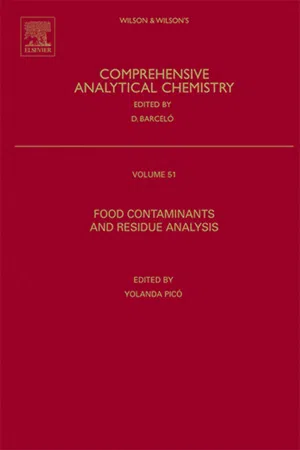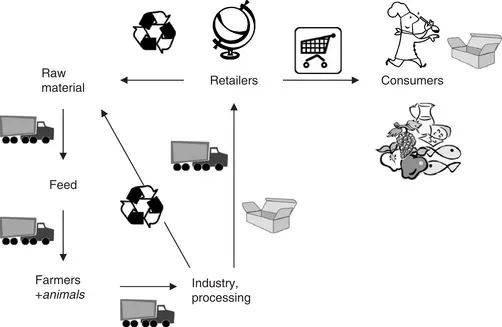Chapter 1 Challenges in Chemical Food Contaminants and Residue Analysis
Michel W.F. Nielen, Hans J.P. Marvin
Abstract
Publisher Summary
This chapter discusses several issues in chemical food contaminants and residue analysis, including (1) a global issue of food chain, (2) issues according to the Rapid Alert System for Food and Feed (RASFF), (3) issues according to the feed and food industry, and (4) issues related to consumer perception. The current use of routine monitoring systems for a limited number of chemical food contaminants and residues in the food industry and food-control laboratories does not mean that the challenges that are being faced are less; the challenges have simply evolved under the influence of globalization, new food technologies, and climate change. In industry, priority is on the implementation of rapid and inexpensive methods having a scope for those substances that are of paramount importance to their specific core product integrity. Recognized challenges are the increase of speed, the reduction of costs, and the extension of scope. The chapter raises some of the emerging issues that require the availability of analysis methods having a comprehensive scope to provide an early warning to the food safety authorities and generate the data for risk assessment.
1 Introduction
Nowadays food is produced and distributed in a global market leading to stringent legislation and regulation for food quality and safety in order to protect consumers and ensure fair trade. Despite these efforts, food safety incidents occasionally occur and originate from both microbial and chemical contamination. Pesticide and veterinary drug residues, endocrine disruptors, food additives and packaging materials, environmental contaminants (including dioxins and heavy metals) and contaminants of natural origin (including mycotoxins and marine toxins) are of particular concern. As a consequence of the introduction of food commodities containing ingredients produced by modern biotechnology and resulting legal requirements of safety and labeling, a strong additional demand for adequate methods of analysis has occurred. Risk analysis provides a framework for regulatory authorities to protect the consumer from potential food safety hazards and is performed in an iterative manner by food safety managers (regulatory authorities), risk assessors (scientists) and stakeholders (i.e., consumers, industry, non-governmental organizations). The assessment of food safety is a scientific exercise performed by scientists and consists of hazard identification, hazard characterization, exposure assessment and risk characterization. An important prerequisite for performing risk assessment adequately is the presence of data generated by reliable and fit-for-purpose analytical methods to estimate the level of exposure and intake of the consumer to contaminants and residues. Hence, the accuracy of risk assessment will benefit from the availability of comprehensive quantitative monitoring and consumption data. However, cost and time considerations of food safety managers (in regulatory institutions and industry) favour the development and implementation of inexpensive and rapid screening methods having a limited scope and providing qualitative or semi-quantitative “on-off” data only. Global food production practices and the changing climate showed that new unexpected food safety hazards and risks may appear in the food and feed production chain stressing the need for analytical tools capable of early warning for such emerging risks. Some of these potential food safety hazards and methodologies capable of detecting known and unknown emerging contaminants are discussed and related challenges defined. It is argued that monitoring programmes should anticipate these new conspicuous threats. In this context a key role is proposed for bioactivity-based screening concepts and bioactivity-directed identification tools.
The development of both rapid screening methods and comprehensive tools covering as many contaminants as possible including emerging and even unknown contaminants is justified by the different needs from food safety stakeholders. The rapid screening developments are facing the challenge of multiplex detection in order to extend their scope, the comprehensive methods on the other hand are facing major challenges in generic sample preparation and advanced data evaluation.
1.1 The food chain: A global issue
The food chain as schematically represented by Figure 1 is rather complex and many factors worldwide play a role in the final issue of food quality and safety.
Raw materials for feed and food production come from all over the world with very different local climate, harvesting and storage conditions, all having an impact on the occurrence of microbiological and chemical contaminants such as mycotoxins, pesticide residues, environmental pollution and packaging migrants. The feed producer will mix different raw materials according to its specifications and add additives such as stabilizers but in some cases also medication. Medicated feed production can cause drug residues in non-medicated feed produced at the same facility due to carry-over. Next, the feed is transported to the first consumer level, i.e., the farm animals. The increased awareness of animal welfare might put a stronger demand on feed-related risk-benefit issues. At the farm stage again additives, but also pesticides, veterinary drugs or even illegal hormones might be applied, which residues and/or metabolites can again build up in the food chain. The food industry produces food products and/or food ingredients but they also yield a waste stream which is at least partly recycled and used as feed ingredient. Packaging into smaller pieces might increase the migration issue of chemicals from the packaging into the food commodity. Following transport the final products come to the retailers where a storage issue might influence the final contamination load. Products being beyond the storage limit date might be recycled and end up in the feed stream again. Finally the consumer buys food that must be stored and prepared for cooking, actions known for their potential introduction of contaminants if hygiene guidelines are not followed. During cooking, food processing contaminants, such as acrylamide, heterocyclic amines and polycyclic hydrocarbons, are introduced but some of the contaminants present might be degraded (or bioactivated) so the real load of dietary intake of contaminants is not so easy to determine. The occurrence of residues from intentionally added chemicals somewhere in the food chain can in theory be avoided, but very much depends on the attitude and behaviour of the actors in the food production chain. Retrospective studies on recent food safety incidents have shown that the human factor (unawareness, fraudulent and illegal actions) plays an important role in the development of food safety incidents [1]. Globalization of food trade, changing climate conditions and agricultural practices, changing food consumption patterns and environmental pollution are all drivers of food safety risks and should be taken into account in systems aimed at identifying emerging food safety hazards and risks. Control of food safety standards, monitoring of contaminants and knowledge about the fate of food contaminants through the entire food chain is needed thus requiring the availability of analysis methods dedicated to the different parts and their actors within the chain.
1.2 Issues according to the Rapid Alert System for Food and Feed
The Rapid Alert System for Food and Feed (RASFF) is primarily a tool for exchange of information between food and feed authorities in the European Union (EU) member states in cases where a risk to human health has been identified and measures have been taken, such as withholding, recalling, seizure or rejection of the products concerned. The European Commission (EC) publishes weekly overviews of RASFF alert and information notifications on its website, and the summarizing annual reports provide an overview of the numbers of notifications and the categories of food products and hazards that they pertained to [2]. These annual reports also highlight conspicuous developments within the particular year. Kleter et al. [3] have explored the utility of notifications filed through RASFF to identify emerging trends in food safety issues. To this end RASFF information and alert notifications published in the four-year period of July 2003–June 2007 amounting to a total of 11,403 notifications were divided into categories and analysed. The breakdown per hazard category is given in Figure 2.
The major categories included chemical (44%), mycotoxins (29%) and microbiological hazards (17%), which together accounted for the majority of the notifications (90%). Within the chemical hazard category, contaminants in products from seafood (30%) and spices and condiments (15%) were the most commonly reported. The most frequently reported are allergens (e.g., sulfite and histamine), heavy metals (e.g., cadmium, mercury and lead), veterinary antibiotics (e.g., the nitrofurans; furazolidone and nitrofurazone, as well as chloramphenicol), dyes (e.g., Sudan 1 and 4) and pesticides (e.g., dimethoate, isophenfos-methyl and omethoate). Aflatoxins account for the majority (93%) of mycotoxins and are mainly (84%) found in nuts, of which (54%) have been imported from Iran. Microbial contaminants include moulds, viruses and bacteria. Bacteria species were most frequently reported of which Salmonella and its subspecies were the most numerous (57% of the reports) followed by Listeria monocytogenes (16%). It should be noted that the number of reports in the RASFF not necessarily reflects the extent of a specific food safety problem because the nature of the RASFF system implicitly yields a multiplication of a specific finding. Based on warnings from the EU member states authorities in other countries will check suspicious lots which will give an additional RASFF notification. Secondly, cost and time considerations limit the scope of survey and monitoring programs, hence many potential food safety hazards will not be monitored at all or at best be accidentally picked up. The application of more generic screening methods such as bioassays in routine monitoring programs may circumvent this problem and increase the chance of finding new (re)emerging food safety hazards. In general, EC regulators and legislators require the availability of fit-for-purpose analysis methods having a comprehensive contaminant scope in order to provide the data for risk assessment, the establishment of maximum residue limits and...


